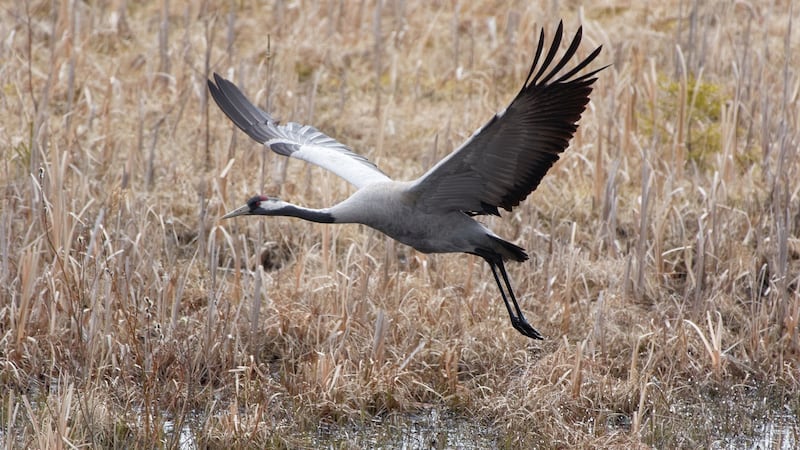Bord na Móna's announcement on August 2nd that common cranes (Grus grus) had bred on their land in May is exciting in itself. These large and dramatically charismatic birds have not produced chicks in Ireland for at least 300 years, though they once played a significant role in our folklore – and in our diet.
Cranes, whether walking or flying, are stately and elegant birds, standing at more than a metre high. They are much taller than the grey heron, with which they are often confused. This confusion is further compounded by the practice in many parts of the country of calling herons “cranes”, which has produced a sudden plethora of “crane” sightings on social media in the wake of Bord na Móna’s announcement.
But if you see a crane in flight, there is no mistaking it, as it flies with its long neck fully outstretched, while the heron tucks its head back to form a tight “S”. And their bugling call is one of the most haunting and evocative in nature.
Describing the musical call of the related American sandhill crane, the pioneer conservationist Aldo Leopold called it "the trumpet in the orchestra of evolution... the symbol of our untameable past, of that incredible sweep of millennia which underlies and conditions the daily affairs of birds and men".
Cranes do have that kind of effect, even on very sober and scientific observers.
Perhaps the most significant aspect of the announcement is that it is a good news story from our chronically degraded peatlands, something almost as rare in Ireland as the cranes themselves.
‘Indicator species’
It is good news for the environment, since cranes are an “indicator species”. Because of their great size, and special feeding and breeding requirements – they build large, often floating, nests in wetlands – their return as breeding birds indicates, though it’s still very early days, that the habitat they have chosen is ecologically rich, and will support many other species.
Notoriously, many of our most important wetlands, including many bogs, are in poor condition and getting worse. So the return of these cranes is all the more remarkable because the particular midlands bog where they nested had been almost completely stripped of its original turf. And it had not yet figured in Bord na Móna’s plans to rehabilitate industrially exploited bogs, primarily by blocking drains.
The name of this bog is not being published to protect the birds at this very early stage of their recolonisation. But, according to the company’s chief ecologist, Mark McCorry, this bogland had “naturally rewetted,” and revegetated, forming a varied mosaic of plant communities where the cranes foraged. He is optimistic that this bodes well for the recovery of threatened species and the return of others we have lost, on the vast lands owned by the company.
However, some independent ecologists are critical of Bord na Móna’s overall plans for their estate, seeing clashes between aspirations to protect and restore biodiversity, and a very ambitious renewable energy agenda. They have called for an independent review.

UCD peatlands specialist Florence Renou-Wilson told this newspaper earlier this year that “it would be a red flag issue to put windmills on restored wetlands”. Wind farms are problematic not so much because of the danger of birds colliding with windmill blades, but because of the significant environmental disturbance their construction causes. This is one of the very tricky triage issues that is emerging in attempting to cope with both the climate change and biodiversity crises at the same time.
Conflicting
The fact that the cranes were nesting on a wetland that the company had not restored shows that this question is more complicated still. Mark McCorry acknowledges that conflicting land uses can be an issue; for example, the bog where the cranes bred is currently under assessment for wind energy use, though no decision has yet been made.
“There are trade-offs between biodiversity and renewable energy that we will have to discuss up the road,” he told The Irish Times. He is confident that no wind farm development will take place where the birds nested, but cannot rule it out on adjacent lands.
The returning cranes face another, very different, problem, rooted in the natural world itself, but where they may need some human help.
Their attempts to breed – assuming it’s the same pair – have been observed on this bog since 2019. And though this is the first year they are known to have produced chicks, and these chicks survived several weeks, they then disappeared, probably the victims of foxes.
The Golden Eagle Trust, which has reintroduced large birds of prey to our landscapes, has been observing the cranes’ behaviour over this period. The trust’s Lorcan O’Toole, who has written a book about the place of cranes in our history and culture, says : “It’s fantastic to see cranes breed in Ireland again. But it’s important to establish protective measures to ensure they can establish a strong foothold.”
The trust removed foxes from adjacent land, and McCorry agrees that some kind of predator control may now be necessary. But he makes the point that this activity also causes some disturbance that could scare off the cranes.
The dilemmas involved in restoring species to our landscape are daunting, but for the moment we can take some solace in a happy event that has not occurred here for centuries.
Paddy Woodworth is the author of Our Once and Future Planet: Restoring the World in the Climate Change Century (2013)

















